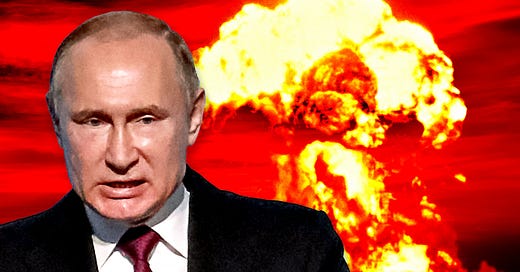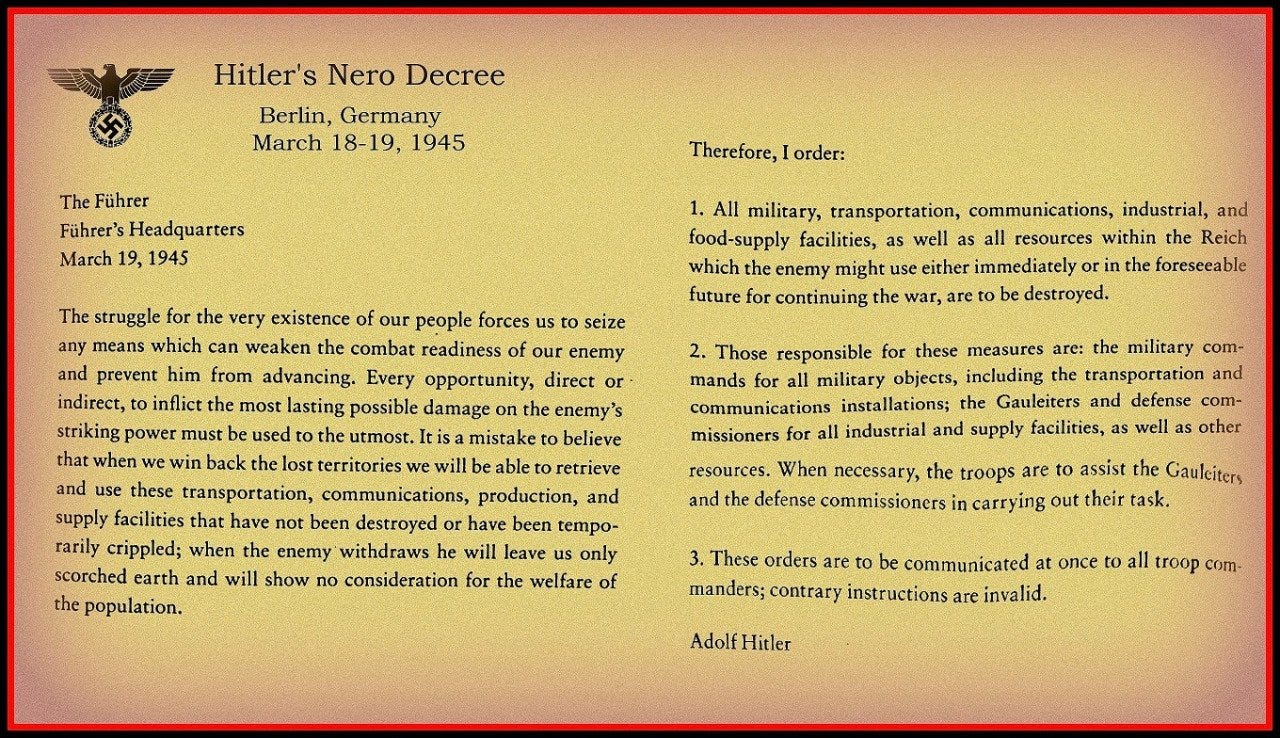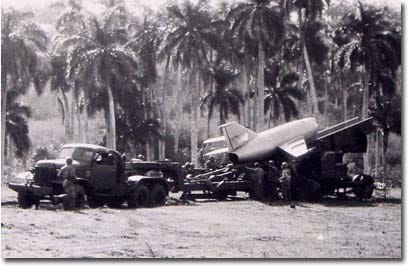Is the Current Moment More Dangerous Than The Cuban Missile Crisis?
You will be worried by the answer
Washington DC 30 October 2022
The danger of a nuclear event is higher now than during the Cuban Missile Crisis. If we survive, historians may or may not determine that the risks of miscalculation or inadvertence were the same, however we already know today’s risk of intentional use is higher. Because the context in 2022 is completely different to 1962. The crisis did not start because the USSR invaded and annex sovereign territory of another state. Khrushchev was not losing a completely unnecessary war of choice against a ‘minor foe’ that he had misjudged would fold in days. The Red Army was not in collapse and retreat. A failed national mobilization was not stirring domestic strife. The Soviet Union did not face global sanctions and international opprobrium of historic proportions. Khrushchev was not being publicly warned by his closest ‘allies’ China and India to end the failing war (a message they are presumably amplifying in private regarding possible nuclear options). Nor did Khrushchev come to power based on a false flag terror operation targeting Russians for sacrifice in his quest for total control. Khrushchev’s power was not absolute. He still had to contend with Kremlin politics, he had not eliminated all competing centers of power. Khrushchev lost the Cuban Missile Crisis but he was not executed or arrested. Had he known in advance those were his options perhaps he would have chosen differently?
Comparatively speaking, the world had a keen understanding of, and focus on, nuclear threats in 1962. Certainly, nuclear war was the top US national security concern however defined - policy, strategy, budget, intelligence, order of battle, operations. Strategic Air Command was the supported command for just about everything and the bomber mafia were in firm control. The general public understood what was at stake.
In 1962 the American public had not lost trust in its leaders on nuclear matters. No Administration dared invoke the threat of a ‘mushroom cloud’ as a casus belli for a major war knowing no such justification existed. That degree of irresponsibility was unknown to Kennedy’s generation. Naturally when the public discovered that there were no Weapons of Mass Destruction (WMDs) in Iraq, pubic will supporting that war started on the road to collapse. So too did the degree of attention and priority accorded to WMDs within the national security apparatus which had already fallen steeply after the end of the Cold War. WMD related organizations within agencies continued their work but they sank in prestige and importance, becoming ever more niche, when in Kennedy’s day they were the primary raison d’etre of the national security state.
Accordingly, the US lost both that war and the justified and needed war from which it distracted national attention, because politicians broke Clausewitz’s cardinal rule and American military commanders did not successfully advise against doing so
“The first, the supreme, the most far-reaching act of judgment that the statesman and commander have to make is to establish by that test the kind of war on which they are embarking; neither mistaking it for, nor trying to turn it into, something that is alien to its nature.”
Life is replete with ironies and the greatest irony of all is just at the moment when we face our greatest real-world nuclear peril, almost no one outside of very niche circles has a clue what is going on.
Another important difference between 1962 and today is Khrushchev was directly threatening the US. Putin is threatening a non-nuclear, non-US Treaty, non-umbrella state with a single low yield weapon. This poses an ‘unconventional nuclear war’ conundrum. Any NATO retaliation to a Russian nuclear weapon that remains under a nuclear threshold will be seen as weak and invite further Russian aggression. Nuclear retaliation would have to be against Russian forces which according to their doctrine would be justification for escalation to general nuclear war. Thus by striking first with a single weapon, Putin would be putting any retaliatory escalation threat to general nuclear war back on the United States. Washington would know, and likely not risk, that the next Russian response to an American nuke on Russian forces near Ukraine, would be a major American city. Thus Putin has a first mover advantage in using a tactical nuke.
Not for the first time, the IC has masterfully cut off Putin’s planned dirty bomb false flag operation by widely publicizing it in advance, undermining any veracity it might have had in propaganda channels. Then again, in 1962 no American was cheerleading Khrushchev like they do Putin today. The inability of these mouthpieces to comprehend how their support of Putin might result in a nuclear strike on the US is representative of how far basic general knowledge of nuclear warfare and international relations has fallen.
One is reminded of Hitler’s “Nero Decree” - to destroy Germany in order to leave Russia a pile of ashes as its spoils of war. As fanatical as the Nazi’s were, they largely did not execute the order. Even Paris was saved by its Nazi governor who refused orders to raze the city. Short of a special operation to deny Putin the ability to issue a Nero Decree (I have some ideas on this), the fate of humanity hangs on a willingness of Putin insiders to act against the dictator. This is not something I’d bet the farm on, because any move, if it fails, results in certain death - the Valkyrie scenario. Yet ironically, failure to remove him also results in certain death, it would just take longer and come at the point of an American ICBM.
On miscalculation, one of my favorite Cuban Missile Crisis authors, Michael Dobbs, had a piece in the NYT on 5 OCT 2022, that noted some key moments in 1962.
As I discovered when I assembled a minute-by-minute chronology of the most dangerous phase of the crisis, there were times when both leaders were unaware of developments on the battlefield that assumed a logic and momentum of their own.
Khrushchev never authorized the shooting down of an American U-2 spy plane over Cuba by a Soviet missile on Oct. 27, 1962, the most dangerous day of the crisis. Kennedy was unaware that another U-2 strayed over Russian airspace the same day, triggering Soviet air defenses. “There’s always some sonofabitch that doesn’t get the word,” was how he put it later.
While the U.S. intelligence community has chalked up some impressive successes in Ukraine, most notably its accurate prediction of Russia’s invasion, which occurred on Feb. 24, the 1962 crisis should serve as a reminder of the limits of intelligence gathering. Kennedy was belatedly informed about the deployment of medium-range Soviet missiles to Cuba, but was left in the dark about other equally important matters. He was unaware, for example, of the presence of nearly 100 Soviet tactical nuclear missiles in Cuba targeted on the Guantánamo naval base and a potential American invading force. The C.I.A. underestimated Soviet troop strength on the island and was unable to track the movement of any of the nuclear warheads.
What both Kennedy and Khrushchev did possess was an intuitive understanding of the peril confronting not just their own countries but the entire world if the crisis was allowed to escalate. That is why they maintained a back channel to communicate with each other privately (through the president’s brother, Attorney General Robert Kennedy, and the Soviet ambassador to Washington, Anatoly Dobrynin) even as they denounced each other publicly. It is also why they acted swiftly to reach a compromise deal (kept secret for decades) that involved the dismantling of U.S. medium-range missiles in Turkey in exchange for a Soviet nuclear withdrawal from Cuba.
Like Kennedy, Khrushchev had experienced the horror of World War II. He knew that nuclear war would be many times more destructive. Kremlin archives show that for all his bloodcurdling rhetoric, Khrushchev was determined to find a peaceful solution as soon as it became clear that his nuclear gamble had failed. Mr. Putin, by contrast, has chosen to raise the stakes at every critical point. Escalation has become his preferred tactic.
Update - Blundering Soviet Brinkmanship
MUST READ
A fascinating new release of hundreds of pages of top-secret documents about Soviet decision-making and military planning in the Cuban Missile Crisis has just been published in Foreign Affairs. It is a must read because like Dobbs’ work, it has excellent detail about all manner of screw ups from strategic to tactical.
The parallels between Khrushchev and Putin are stark. Both sold their plans to their own armies as “exercises”. Both forced their politburo to sign on to the plan in advance, in an attempt to prevent palace intrigue if things did not go well. Both made massive miscalculations. The only difference might turn out to be that where Khrushchev was willing to back off, Putin might be forced to double down. After all, unlike Ukraine, the CMC did not turn hot. The failures were mostly concealed from the world. Putin’s failures are there for all to see.
Putin’s miscalculations ensured the exact opposite of his war aims. Western/EU unity, NATO enlargement, and the doubling of direct NATO contact on Russia’s border. Putin portrays himself as a modern Stalin. The addition of Finland to NATO, which is a significant military power in its own right, is also a potent reminder of Stalin’s folly of 1939 that Putin has repeated in Ukraine. Long term, Putin will be remembered for transforming Russia into a Chinese vassal state.
The article is a case study in the importance of having Red Team analytical checks on assumptions, plans and policy.
A small coterie of high officials who knew nothing about Cuba, acting in extreme secrecy, drew up a sloppy plan for an operation that was doomed to fail and never allowed anyone else to question their assumptions.
One of the commanders wrote afterwards “the whole operation should have been preceded at least by a minimal acquaintance and study”. All sorts of simple mistakes were made. An initial cursory examination by a senior officer assumed Cuba’s tropical foliage would provide ample cover for the operation. When the fielded forces conducted a proper site survey and recommended areas not pre-selected by Moscow, they were ignored. Russian camouflage nets “matched the green foliage of Russia and stood out sharply against the sun-scorched Cuban landscape.” No action was taken to remediate any of these problems.
Another problematic assumption - that the following order of battle could be explained away as part of an “exercise”
44,000 Russian troops
60 ICBMs measuring 80 feet long and [each weighing] 86 metric tons
Some 8,000 trucks and cars,
500 trailers, and
100 tractors were sent, along with
31,000 metric tons of fuel for cars, aircraft, ships, and, of course, missiles.
two antiaircraft divisions,
one regiment of IL-28 bombers,
one air force squadron of MiG fighters,
three regiments with helicopters and cruise missiles,
four infantry regiments with tanks, and support and logistics troops.
Even excluding the missiles, it did not occur to anyone that a deployment on that scale, requiring 85 ships, might not pass the “exercise” sniff test in Washington and thus trigger intensive ISR patrols leading to war preparation.
The following list of warheads were on the island - all except the strategic warheads were unknown to Kennedy.
Strategic Warheads
60 x 1 Mt warheads for the R12 and R-14 missiles
Tactical Warheads
98 total “Tactical” warheads including
80 14kt Hiroshima sized warheads for FKR cruise missiles,
12 2kt warheads for Luna/FROG missiles and
6 12kt bombs for the IL-28 bombers
The article continues with gems including the role of chance, luck and unintended consequences.
The storage facility for the R-12 nuclear warheads was located at a considerable distance from the missile sites: 70 miles from one regiment, 90 miles from another, and 300 miles from another. If Moscow gave an order to fire the missiles at U.S. targets, the Soviet commanders in Cuba would need between 14 and 24 hours to truck the warheads across miles of often treacherous terrain.
Kennedy knew nothing about these logistical challenges. But their existence suggests yet again the role of luck. Many in the group, known as EXCOMM, favored an all-out attack on Cuba to obliterate the Soviet bases. Had EXCOMM learned of these difficulties, the hawks would have had a stronger argument in favor of an all-out strike on Cuba—which would probably have disabled the missiles but could have led to a war with the Soviet Union, whether in Cuba or Europe.
The biggest takeaway is straight forward: how on earth are we all alive? Will our luck run out in the service of Putin’s hubris?








This all hangs on Russian culture which is very different to US culture. Dont expect it to operate on the same logic or rules. It went from Tzar to Stalin (Tzar) to sort of democrat for a few years (Yeltsin) to Tzar.
You really don't want to read Command and Control by Schlosser. You'll never sleep again.